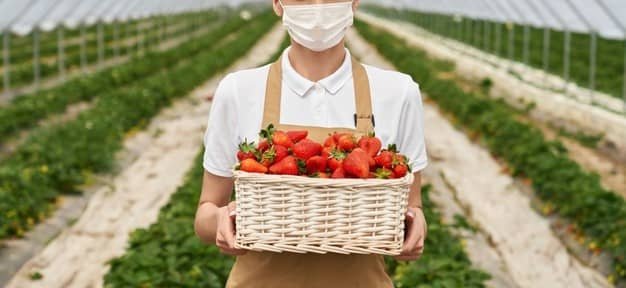Definition of Harvesting
Harvesting is the process by which agricultural commodities are detached from their mother plants for consumption or sale or for other purposes.
Or, Harvesting is the deliberate picking of the commodity from the plants.
Harvesting indices
It refers, the economic yield of a crop in comparison with the actual total yield. For the determination of optimal harvesting maturity, it is a necessary tool and for this maturity, indices should be known.
Harvesting of fruits should be done at the optimum stage of maturity. During harvesting operations, a high standard of field hygiene should be maintained. It should be done carefully at the proper time without damaging the fruits. The harvesting operation includes.
- Identification and judging the maturity of fruits.
- Selection of mature fruits.
- Detaching or separating the fruits from the tree.
- Collection of matured fruits.
Method of Harvesting Fruits and Vegetables

Different kinds of fruit and vegetables require different methods of harvesting. The methods of harvesting are:
- Manual Harvesting.
- Mechanical Harvesting.
1. Manual Harvesting: Harvesting by one’s own hand is called manual harvesting. Hand harvesting has a number of advantages over machine harvest. People can accurately determine product quality, allowing an accurate selection of mature products. This is particularly important for crops that have a wide range of maturity and need to be harvested several times during the season.
It is done in several ways:
- Ladder/bag picking method.
- Poles/Clippers method.
- Harvesting by means of cutting knives.
- Harvesting by means of digging tools.
2. Mechanical Harvesting: In this method, a number of mechanical devices are used for harvesting the produce on a commercial scale. Mechanical harvest is currently used for fresh-market crops that are roots, tubers, or rhizomes and for nut crops. Vegetables that are grown below ground (radishes, potatoes, garlic, carrots, beets, and others) are always harvested only once and the soil can be used to cushion the product from machine-caused mechanical injury. Tree nuts and peanuts are protected by a shell and easily withstand mechanical handling.
Points to be considered during harvesting fruits and vegetables
- Produce should be collected with care to avoid injury and damage.
- Market demands in terms of size and stage of maturity should be considered.
- Containers and harvesting tools should be clean and free from rough edges.
- Stackable and nestable plastic crates should be used as field containers during harvest. Plastic crates are durable, reusable, and can easily be cleaned.
- The harvesters should be properly trained on harvesting methods and proper stages of maturity.
- Produce that has fallen or touched the ground should not be harvested.
- Shade should be provided over the harvested produced to prevent heat and sun damage and reduce the rate of nutrient degradation.
- Suitable time for harvesting horticultural produce is the early morning.
- The harvesting tools and equipment should be disinfected with chlorine water.
Effects of maturity on physico-chemical changes and ripening
Harvest maturity has a great influence on the post-harvest quality of fruits and vegetables. For example, Mango fruits harvesting at mature and have mature stages produced good quality characteristics when ripened at 25°C. The mature fruits are observed to have a faster rate of ripening compared to the half mature and immature fruits. The immature fruit only showed limited quality changes during ripening and normal physico-chemical changes did not fully occur.
Chemical composition
Chemical changes are often used in determining the maturity of mango fruit for harvest. Total soluble solids, starch, Sugars, total carotenoid pigments, and pH are correlated positively with mature; whereas moisture content, acidity, ascorbic acid, and tannins are correlated negatively.
Rate of respiration
The rate of respiration of mango fruits varies with various stages of maturity and ripening. Respiration attains its maximum at the ripe stage compared to the unripe and senescent stage.
Ethylene production
In general, the rate of Ethylene production remains lower in the preclimacteric phase and increases considerably in the climacteric phase. Mature and half mature fruits showed a higher rate of ethylene production, ripened normally, and maintained acceptable flavor and aroma when compared with immature fruits.
Ripening of the immature fruits was insufficient as revealed by low ethylene production, poor color development, minor changes to fruit composition, insipid flavor, and poor aroma. Although the rate of Ethylene production remained low during the later stages of maturation, a peak in ethylene production was observed about 10 days prior to harvest maturity.
Rate of ripening
Fruit ripening also depends on the stage of maturity at harvest. Ripening of mango fruits at low temperature was effectively retarded in the immature fruits compared with mature fruits of the variety ‘Amelie’. In contrast, the variety ‘Sensation’ ripened rapidly irrespective of harvest maturity. When the mature fruits were ripened at 25°C, they failed to develop the characteristics of full ripeness. Exposure of mature and half mature fruits to acetylene (1.6 mL/L) and ethylene (1.0 mL/L) for 8 hours resulted in the initiation of full ripening, whereas mature fruits failed to fully ripen.
